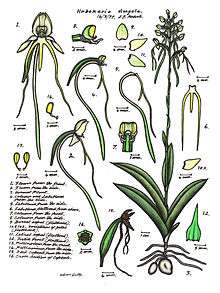Habenaria elongata
Habenaria elongata, commonly known as the white rein orchid,[2] or Kimberley spider orchid,[3] is a species of orchid that is endemic to northern Australia. It has up to four leaves at its base and up to twenty small white flowers with yellowish tips and thread-like lobes on the labellum.
| White rein orchid | |
|---|---|
 | |
| Drawing of H. elongata by Lewis Roberts | |
| Scientific classification | |
| Kingdom: | Plantae |
| Clade: | Tracheophytes |
| Clade: | Angiosperms |
| Clade: | Monocots |
| Order: | Asparagales |
| Family: | Orchidaceae |
| Subfamily: | Orchidoideae |
| Tribe: | Orchideae |
| Genus: | Habenaria |
| Species: | H. elongata |
| Binomial name | |
| Habenaria elongata | |
Description
Habenaria elongata is a tuberous, perennial herb with between two and four oblong to egg-shaped leaves at its base, the leaves 80–120 mm (3–5 in) long and 20–25 mm (0.8–1 in) wide. Between eight and twenty white flowers with yellow tips, 25–35 mm (0.98–1.4 in) long and 20–25 mm (0.8–1 in) wide are borne on a flowering stem 300–600 mm (10–20 in) tall. The dorsal sepal is 4–5 mm (0.16–0.20 in) long, about 3 mm (0.1 in) wide, overlapping with the base of the petals to form a hood over the column. The lateral sepals are 5–5.5 mm (0.20–0.22 in) long, about 2 mm (0.08 in) wide and turn downwards behind the labellum. The petals are about 6 mm (0.2 in) long and 3 mm (0.1 in) wide. The labellum turns downwards and has three lobes, the side lobes very narrow linear to thread-like, 15–20 mm (0.6–0.8 in) long and the middle lobe 5–7 mm (0.2–0.3 in) long. The nectary spur is curved and 5–7 mm (0.2–0.3 in) long. Flowering occurs in January and February.[2][3][4]
Taxonomy and naming
Habenaria elongata was first formally described in 1810 by Robert Brown and the description was published in Prodromus Florae Novae Hollandiae et Insulae Van Diemen.[5][6] The specific epithet (elongata) is a Latin word meaning "prolonged",[7] referring to the three long labellum lobes.[3]
Distribution and habitat
The white rein orchid is found in the Kimberley region of Western Australia, northern parts of the Northern Territory, on the Cape York Peninsula and in New Guinea. It grows in grassland, open forest and woodland.[2][3][4]
References
- "Habenaria elongata". World Checklist of Selected Plant Families (WCSP). Royal Botanic Gardens, Kew.
- Jones, David L. (2006). A complete guide to native orchids of Australia including the island territories. Frenchs Forest, N.S.W.: New Holland. p. 341. ISBN 978-1877069123.
- Brown, Andrew; Dundas, Pat; Dixon, Kingsley; Hopper, Stephen (2008). Orchids of Western Australia. Crawley, Western Australia: University of Western Australia Press. p. 495. ISBN 9780980296457.
- "Habenaria elongata". Orchids of New Guinea. Retrieved 22 August 2018.
- "Habenaria elongata". APNI. Retrieved 22 August 2018.
- Brown, Robert (1810). Prodromus florae Novae Hollandiae. London. p. 313. Retrieved 28 August 2018.
- Brown, Roland Wilbur (1956). The Composition of Scientific Words. Washington, D.C.: Smithsonian Institution Press. p. 494.